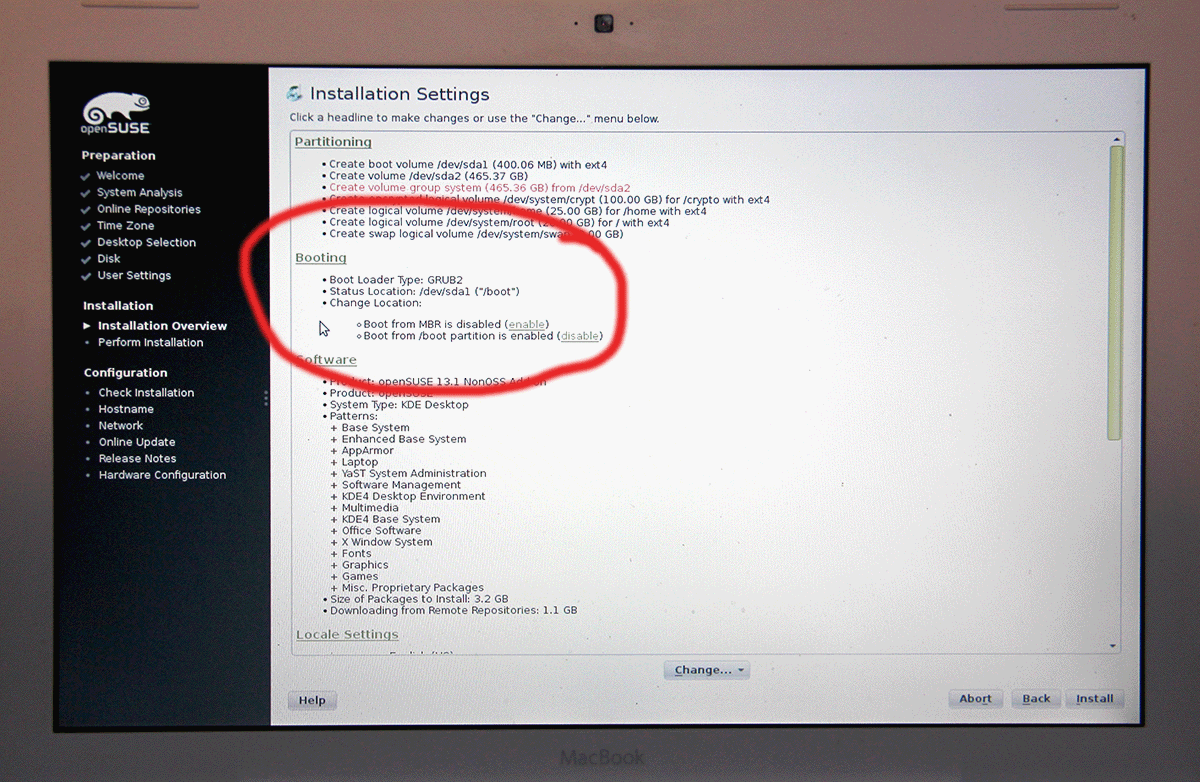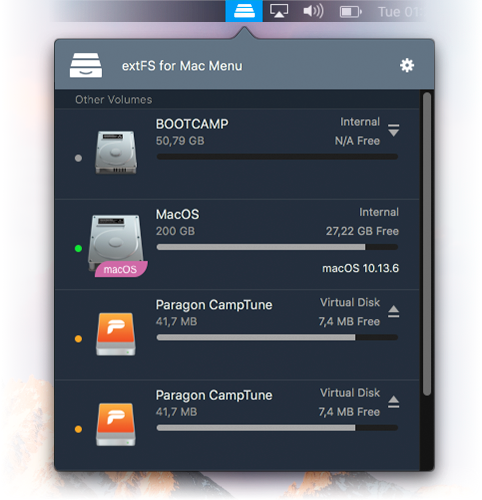This guide outlines special information on installing and configuring Arch on the more recent Macbook 9,x (Mid-2012) hardware alongside a pre-existing OSX operating system. This requires adequate free disk space, install media (such as a USB or CD), and a wired connection for the initial steps of the install procedure.
There have been different possibilites to mount Linux Ext2/Ext3 volumes in the Mac OS X Finder: Mac OS X Ext2 Filesystem- which sadly doesn't seem to work any more with recent distros.; ext2 filesystem in user space, with an available experimental Mac OS X package (from the author of NTFS-3G/Mac). Both these projects, however, don't seem to be developed any more. Is it possible to mount a Linux ext4 partition on Mac OS X? Please describe the procedure - risk free - thanks. Edit Aug 2012 The best solution I found was to use a 2nd machine with Linux, mou.
- The latest setup of system file ext4 has been released by its developers and available on this page for free download. If you are looking for its latest setup, kindly follow download section menu. There are several other sites which are providing free files. The primary apparatus Ext4 Unpacker changes over the system.img record into an EXT4.
- If you enable Recovery Vault to protect your drives in Disk Drill, your files will be recovered much faster and with much higher accuracy. If you ever need to recover missing partition on Mac OS X, the Recovery Vault database will be found during scanning and you will be able to recover your files using our award-winning unique Mac partition recovery software.
This article is written with a dual-boot setup in mind, and does not cover how to replace OSX with Arch.
For general help on the install preocedure see the Installation guide
- 1Preparation
- 2Installation
- 2.2Running the Arch installation
- 3Post Installation
- 3.4Inverting FN keys
- 4Bells & Whistles
- 4.1Emulating OSX Touchpad Gestures
Preparation
Recording UIDs
If you want to access your OSX user directories from Linux, write down the UID and GID for the users.
Install Boot Manager
Optional. The easiest way to begin is by installing rEFInd on Mac OSX before moving on to Arch. This will place a boot menu on startup. The config will be in your OSX partition - if this is not desirable it is possible to install it later in Arch. For more information consult UEFI.
Shrinking Macintosh HD
How to check for virus on mac pro. Although nowadays Boot Camp requires a Windows installation disc before altering partitions, it is possible to do this using Mac OSX's disk utility. Create a new partition, calculate the amount of free space required for all new partitions and shrink Macintosh HD to accommodate for this amount. Leave the new partition as free space for now.
Installation

Preparing installation media
Download Arch and burn it to a USB, CD or DVD, and boot into the Arch install.
Running the Arch installation
Proceed from the Installation section in Installation guide#Installation. Note that you'll need a wired connection to continue for now.
The following differences will apply to MacBooks:
Sample partition layout
For sharing files between OSX and Linux, a number of filesystem options exist. FAT32 is natively supported on all systems - however, it lacks support for filesystems larger than 2TB or files larger than 4GB. Journaled HFS+ partitions, such as the Macintosh HD partition, will only mount read-only in Linux. Full read-write support is available for unjournaled HFS+ filesystems. ExFAT support can be made available by installing exfat-utils.
Install boot loader
Follow the relevant page for the chosen boot loader listed in Arch boot process#Boot loader. Launchbar 6 7 2 – powerful fileurlemail launcher utility.
Post Installation
Continue with General recommendations, noting the following modifications:
SD Card Reader
The sdcard reader does not work properly with the highest speeds currently and may never work properly. To get it working you will have to sacrifice the ultra fast modes and use a quirk in your boot parameters. Ommwriter 1 55.
Users
If you wrote down your OSX uid's and gid's eariler, new users can be created by running:
In order to be able to access a OSX user's directory, only the uid and gid need to match. (usernames can differ)
Wireless
Macbooks 8,1 to 9,2 (and possibly newer) use BCM4331 for Wifi. See Broadcom wireless for details.The Mac Mini 5.1 Also uses the Broadcom BCM4331 Wi-Fi Chip.
Inverting FN keys
To make the FN keys function as normal FN keys, follow Apple Keyboard#Function keys do not work.
Wireless Flakiness
Popchar 8 9 64. The only connection manager combination with BCM4331 that doesn't result in flakiness seems to be connman + disabled background scanning.

Preparing installation media
Download Arch and burn it to a USB, CD or DVD, and boot into the Arch install.
Running the Arch installation
Proceed from the Installation section in Installation guide#Installation. Note that you'll need a wired connection to continue for now.
The following differences will apply to MacBooks:
Sample partition layout
For sharing files between OSX and Linux, a number of filesystem options exist. FAT32 is natively supported on all systems - however, it lacks support for filesystems larger than 2TB or files larger than 4GB. Journaled HFS+ partitions, such as the Macintosh HD partition, will only mount read-only in Linux. Full read-write support is available for unjournaled HFS+ filesystems. ExFAT support can be made available by installing exfat-utils.
Install boot loader
Follow the relevant page for the chosen boot loader listed in Arch boot process#Boot loader. Launchbar 6 7 2 – powerful fileurlemail launcher utility.
Post Installation
Continue with General recommendations, noting the following modifications:
SD Card Reader
The sdcard reader does not work properly with the highest speeds currently and may never work properly. To get it working you will have to sacrifice the ultra fast modes and use a quirk in your boot parameters. Ommwriter 1 55.
Users
If you wrote down your OSX uid's and gid's eariler, new users can be created by running:
In order to be able to access a OSX user's directory, only the uid and gid need to match. (usernames can differ)
Wireless
Macbooks 8,1 to 9,2 (and possibly newer) use BCM4331 for Wifi. See Broadcom wireless for details.The Mac Mini 5.1 Also uses the Broadcom BCM4331 Wi-Fi Chip.
Inverting FN keys
To make the FN keys function as normal FN keys, follow Apple Keyboard#Function keys do not work.
Wireless Flakiness
Popchar 8 9 64. The only connection manager combination with BCM4331 that doesn't result in flakiness seems to be connman + disabled background scanning.
Keyboard Backlight
A 'just works' solution is the acpibacklightAUR[broken link: package not found] package. It provides the just work case when controlling it with the keyboard shortcuts. Busy contacts 1 4 5 140501 8.
Xorg
Main Page: Xorg
Ext4 Macbook Hard Drive
Install xf86-video-intel and setup Xorg as you normally would.
The built-in keyboard and most usb input devices will work out-of-the-box, but xf86-input-synaptics is needed in order to use the built-in touchpad.
Bells & Whistles
Emulating OSX Touchpad Gestures
With a little bit of work it's possible to tweak the multitouch options on the trackpad. This can be achieved with a combination of X11 driver settings and open source software.
Setting Up A New Macbook
Using synclient
synclient is included with the xf86-input-synaptics driver. It is useful for experimenting with settings as they take effect immediately and expire at the end of an X session. Clearview 2 1 15. Many OSX options can be emulated without any additional software.
Run synclient -l to have a look at all the available options. Here are some suggestions which resemble the options found in OSX's System Preferences:
- By default synaptics is configured to use a double-tap drag gesture found on older touchpads - one may argue that this is not necessary on a clickpad.
synclient TapAndDragGesture=0will turn this off. - TapButtonX and ClickFingerX sets the mouse button triggered by tapping or clicking with X fingers. set
TapButton2=3andClickFinger2=3to assign two-finger click to the right mouse button. - Setting the bottom-right corner click to right mouse button can be done by subtracting about 500 from
RightEdgeandBottomEdgeand plugging the new values intoRightButtonAreaLeftandRightButtonAreaTop. If the last two options are not visible, setClickpad=1.
To make settings permanent, just modify /etc/X11/xorg.conf.d/10-synaptics.conf.
/usr/local/bin/synarea.sh with the required synclient commands, and add the script to the X startup sequence.